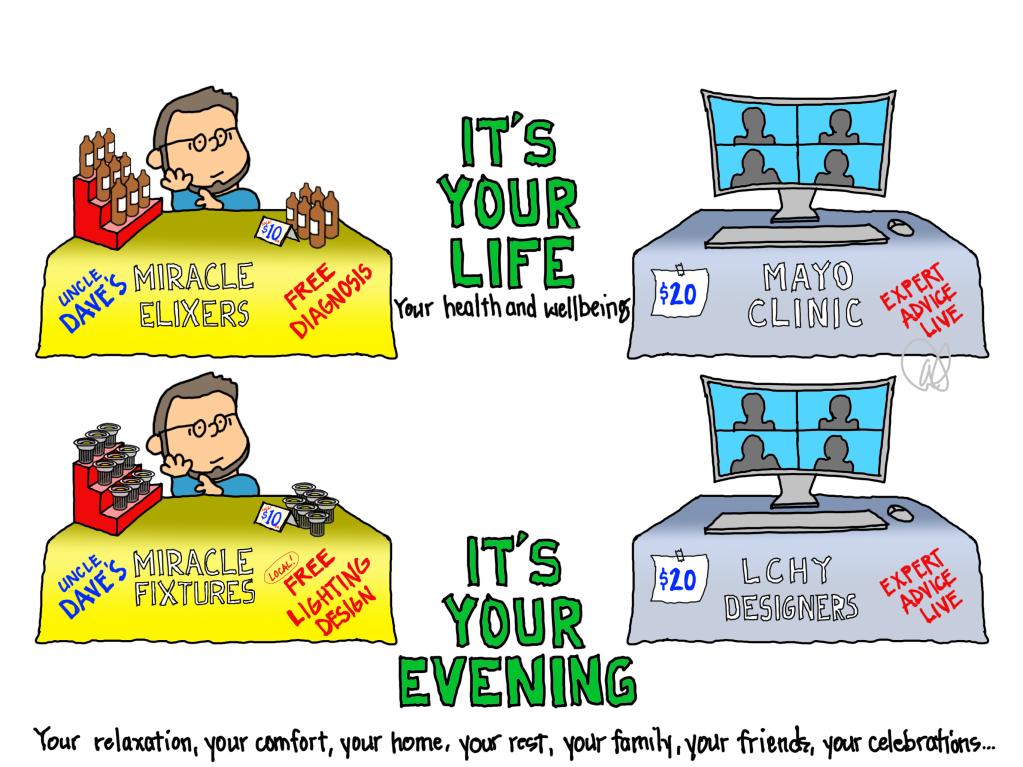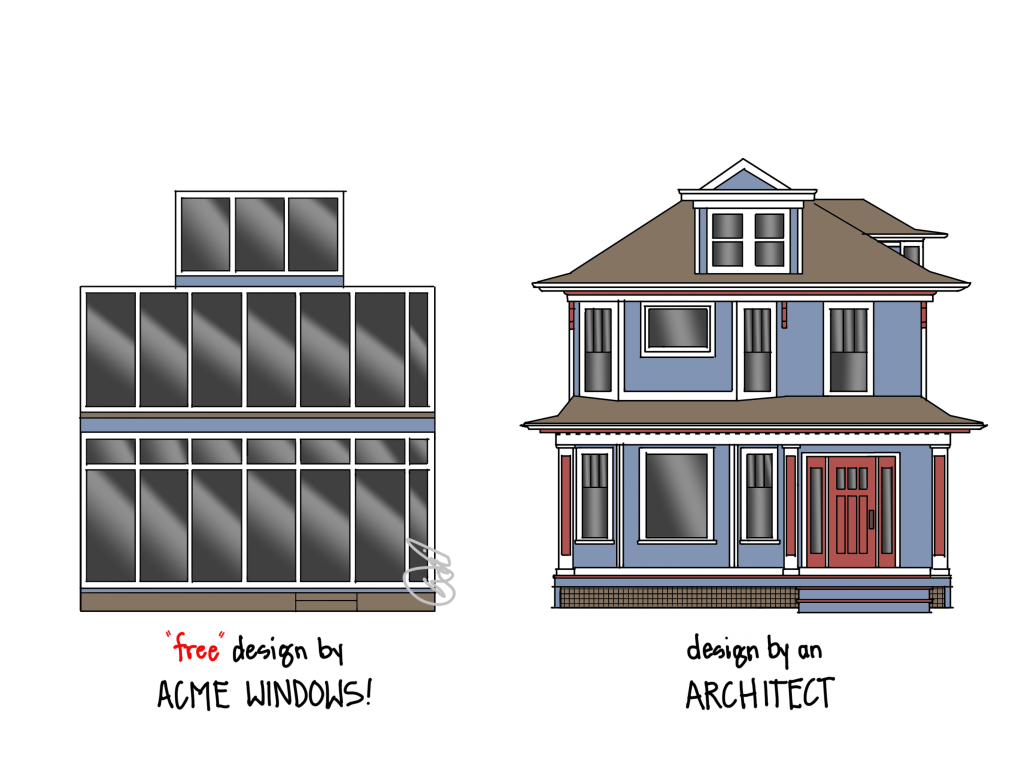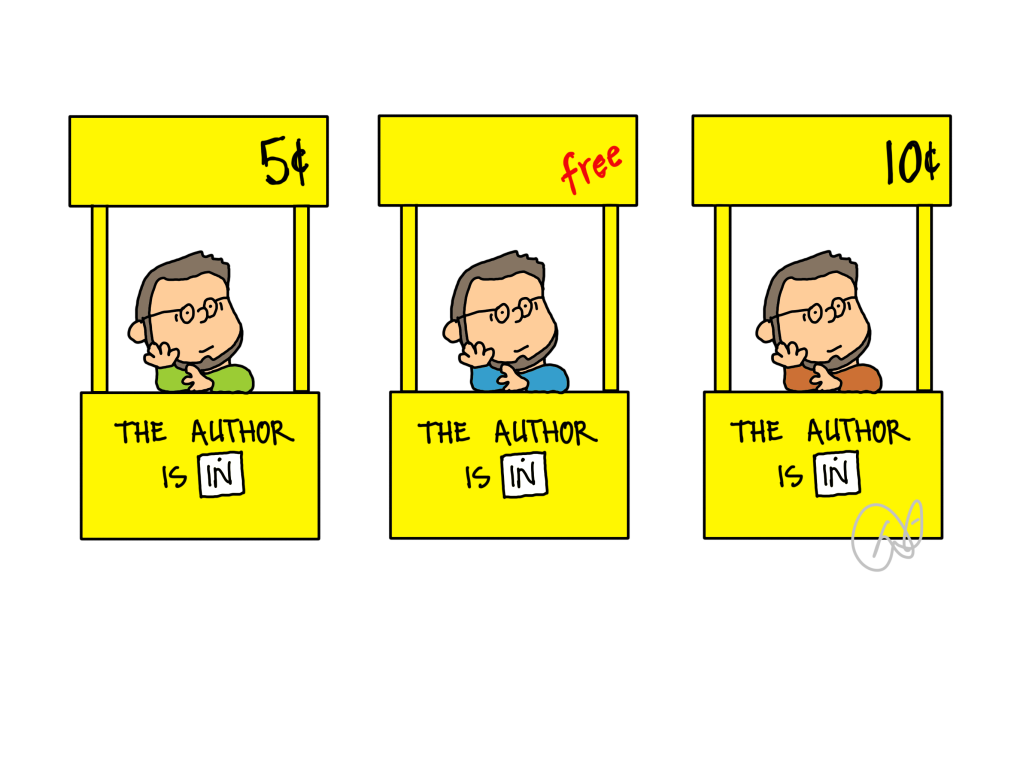We recently lost a potential client to a manufacturer who offered “free” lighting design services (so long as you purchased fixtures from them, of course, which have the cost of service buried into the sale price). My first reaction was indignation but, as is often the case, a closer look revealed a much more nuanced situation. And as an advocate for more accessible lighting design services – which inherently must be lower priced – did I have any footing at all to be upset?
I often understand situations more deeply when I try on different analogies, and this conundrum is no different. Enter the comic above, inspired by Peanuts and Lucy’s psychiatry booth.
Imagine you are a graduate student who has been instructed by your advisor “to get some writing help from an author.”
You roll up to the local authors market (ha!) and see three booths set up. One offers writing for five cents, another for ten cents, and another for free. Which one do you choose? If you’re smart, you choose the free one, because they all appear to offer the same service.
But rarely, if ever, do three businesses offer the exact same services. Now imagine there are a few more details on the booths. If you were looking for help on your graduate thesis, is “free” really the best option? You will get some writing, for sure, but it would take a very unique graduate program to accept dad jokes as scholarly writing.
Prospective clients face a similar situation: they are often advised to consider lighting design but are unlikely to be able to tell the difference between one service and another, except where price is concerned. Even the most un-trained client can tell the difference between $15,000 and Free.
I wish it was easy to see the difference in lighting design services, but sadly there is no real way for the consumer to tell one from another, at least at the typical point of sale. As an unregulated profession, anyone in the world can decide today to call themselves a lighting designer, add it to their email signature, and start selling design services. And any business that makes money selling light fixtures can offer lighting design services that appear to be free. As a dedicated lighting designer who sells no product, I can never compete with free.
Frankly, that’s okay with me. I think there should be a variety of services available to the public because not everyone can afford the services of a dedicated lighting professional. But there needs to be a way to tell a dad joke from an essay from a thesis.

Enter another analogy: the local Wellness Fair. You have a health issue – let’s call it chronic acid reflux or heartburn – and are looking for some help. You could stop by my table of Miracle Elixers, because I offer “free” lighting design, er, diagnosis. Guess what? I am 99% likely to suggest my product as the cure for your ills.
The next table does not have any staff at all. Instead, there is a digital kiosk with a live Zoom call set up with doctors from the Acid Reflux Department at Mayo Clinic. A call with them is $20.
If you want to feel better, which is the best option? The “free” diagnosis that inevitably comes with a recommendation for several bottles of my $10 product? Or the $20 call with world-class experts who may end us prescribing a very different solution?
You would likely make the smart decision and get on the call with Mayo. So why trust your lighting design to my “Miracle Fixtures – Free Lighting Design” service? You do not have to pay me for design because you are going to pay me for fixtures. And I am 99% likely to “design” my own products- and only my products- for your home.

Again, this is not bad, but it is different. I know there are some very talented people offering these services through manufacturers and retailers. They may even be better designers than I am, but they will literally lose their job if their employer is not satisfied with how many of their own fixtures are sold. Economics are a powerful motivator. A free home design by ACME windows will…sell you more windows.
What if you could hop on a Zoom call with talented, dedicated lighting experts? That’s our model – offering remote lighting design services across the continent and beyond – and it can seem a bit weird when the local retailer is offering “local, free” lighting design.
That may be the right choice, perhaps you just need the most cost-affordable, instantly-accessible solution to get light into your home. Just be aware that the results are going to be different than if you engage dedicated designers not beholden to a single product line. Free lighting design is not worthless. But it may be worth less.
As an aside, I think I look pretty cute behind the Miracle Fixtures booth, as I neglected to sketch my wrinkles and gray hair. So maybe you’ll see me at the local building fair someday….
